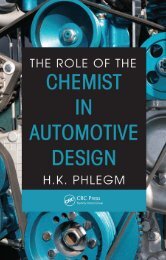Lightweight Electric/Hybrid Vehicle Design
Lightweight Electric/Hybrid Vehicle Design
Lightweight Electric/Hybrid Vehicle Design
Create successful ePaper yourself
Turn your PDF publications into a flip-book with our unique Google optimized e-Paper software.
Battery/fuel-cell EV design packages 125<br />
The EV1 can be charged safely in all weather conditions with inductive charging. Using a<br />
220 volt charger, charging from 0 to 100% for the new lead–acid pack takes up to 5.5–6 hours.<br />
Charging for the nickel–metal hydride pack, which stores more energy, is 6–8 hours. Braking is<br />
accomplished by using a blended combination of front hydraulic disk, and rear electrically applied<br />
drum brakes and the electric propulsion motor. During braking, the electric motor generates<br />
electricity (regenerative) which is then used to partially recharge the battery pack. The aluminium<br />
alloy structure weighs 290 pounds and is less than 10% of the total vehicle weight. The exterior<br />
composite body panels are dent and corrosion resistant and are made from SMC and RIM polymers.<br />
The EV1 is claimed to be the most aerodynamic production vehicle on the road today, with a 0.19<br />
drag coefficient and ‘tear drop’ shape in plan view, the rear wheels being 9 inches closer together<br />
than the front wheels. The EV1 has an electronically regulated top speed of 80 mph. It comes with<br />
traction control, cruise control, anti-lock brakes, airbags, power windows, power door locks and<br />
power outside mirrors, AM/FM CD/cassette and also a tyre inflation monitor system.<br />
5.5.3 AC DRIVES<br />
An interesting variant on the AC-motored theme, Fig. 5.16, is the use of a two-speed transaxle<br />
gearbox which reduces the otherwise required weight of the high speed motor and its associated<br />
inverter. A system developed by Eaton Corporation is shown at (a) and has a 4 kW battery charger<br />
incorporated into the inverter. A 3 phase induction motor operates at 12 500 rpm – the speed being<br />
unconstrained by slip-ring commutator systems. A block diagram of the arrangement is at (b) and<br />
is based on an induction motor with 18.6 kW 1 hour rating – and base speed of 5640 rpm on a 192<br />
V battery pack. The pulse width modulated inverter employs 100 A transistors. The view at (c)<br />
shows the controller drive system functions in association with the inverter. In an AC induction<br />
motor, current is applied to the stator windings and then induced into the windings of the rotor.<br />
Motor torque is developed by the interaction of rotor currents with the magnetic field in the air<br />
gap between rotor and stator. When the rotor is overdriven by coasting of the vehicle, say, it acts<br />
as a generator. Three phase winding of the stator armature suits motors of EV size; the rotor<br />
windings comprise conducting ‘bars’ short-circuited at either end to form a ‘cage’. Rotation speed<br />
of the magnetic field in the air gap is known as the synchronous speed which is a function of the<br />
supply-current frequency and the number of stator poles. The running speed is related to<br />
synchronous speed by the ‘slip’.<br />
If two alternators were connected in parallel, and one was driven externally, the second would<br />
take current from the first and run as a ‘synchronous motor’ at a speed depending on the ratio of<br />
each machine’s number of poles. While it is a high efficiency machine which runs at constant<br />
speed for all normal loads, it requires constant current for the rotor poles; it is not self-starting and<br />
will stop if overloaded enough for the rotor to slip too far behind the rotating stator-field. Normally,<br />
the synchronous motor is similar in construction to an induction motor but has no short-circuited<br />
rotor – which may be of the DC-excited, permanent-magnet or reluctance type.<br />
The view at (d) shows a stator winding for a 2 pole 3 phase induction motor in diagrammatic<br />
form. If supply current frequency is f , then stator field speed is f /p for number of poles p. Rotor<br />
s s<br />
current frequency f = sf where s is the slip. Power supplied to a 3 phase motor can be expressed<br />
r p<br />
as EI(3) 1/2f n where n is efficiency. When a synchronous motor has no exciting voltage on the rotor<br />
s<br />
it is termed a ‘reluctance’ motor which has very simple construction and, when used with power<br />
transistors, can be applied as a variable speed drive. Axial air-gap versions are possible as at (e);<br />
such an electronically commutated motor can operate with a DC source by periodic reversal of the<br />
rotor polarities.<br />
The general form of control, with DC link inverter, for induction motors is shown<br />
diagrammatically at (f). The thyristors of the inverter are generally switched so as to route current







